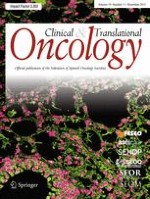Published in:

01-11-2017 | Research Article
Prognostic value of maximum standardized uptake value measured by pretreatment 18F-FDG PET/CT in locally advanced head and neck squamous cell carcinoma
Authors:
J. Cacicedo, I. Fernandez, O. del Hoyo, A. Navarro, A. Gomez-Iturriaga, J. Ignacio Pijoan, L. Martinez-Indart, J. Escudero, J. Gomez-Suarez, R. Ortiz de Zarate, J. Fernando Perez, P. Bilbao, D. Rades
Published in:
Clinical and Translational Oncology
|
Issue 11/2017
Login to get access
Abstract
Purpose/objectives
To evaluate the prognostic impact of maximum standardized uptake value (SUVmax) in patients with locally advanced head and neck squamous cell carcinoma (HNSCC) undergoing pretreatment [F-18] fluoro-d-glucose-positron emission tomography/computed tomography (FDG PET/CT) imaging.
Materials/methods
Fifty-eight patients undergoing FDG PET/CT before radical treatment with definitive radiotherapy (±concomitant chemotherapy) or surgery + postoperative (chemo)radiation were analyzed. The effects of clinicopathological factors (age, gender, tumor location, stage, Karnofsky Performance Status (KPS), and treatment strategy) including primary tumor SUVmax and nodal SUVmax on overall survival (OS), disease-free survival (DFS), locoregional control (LRC), and distant metastasis-free survival (DMFS) were evaluated. Kaplan–Meier survival curves were generated and compared with the log-rank test.
Results
Median follow-up for the whole population was 31 months (range 2.3–53.5). Two-year OS, LRC, DFS and DMFS, for the entire cohort were 62.1, 78.3, 55.2 and 67.2%, respectively. Median pretreatment SUVmax for the primary tumor and lymph nodes was 11.85 and 5.4, respectively. According to univariate analysis, patients with KPS < 80% (p < 0.001), AJCC stage IVa or IVb vs III (p = 0.037) and patients undergoing radiotherapy vs surgery (p = 0.042) were significantly associated with worse OS. Patients with KPS < 80% (p = 0.003) or age ≥65 years (p = 0.007) had worse LRC. The KPS < 80% was the only factor associated with decreased DFS (p = 0.001). SUVmax of the primary tumor or the lymph nodes were not associated with OS, DFS or LRC. The KPS < 80% (p = 0.002), tumor location (p = 0.047) and AJCC stage (p = 0.025) were associated with worse cancer-specific survival (CSS). According to Cox regression analysis, on multivariate analysis KPS < 80% was the only independent parameter determining worse OS, DFS, CSS. Regarding LRC only patients with IK < 80% (p = 0.01) and ≥65 years (p = 0.01) remained statistically significant. Nodal SUVmax was the only factor associated with decreased DMFS. Patients with a nodal SUVmax > 5.4 presented an increased risk for distant metastases (HR, 3.3; 95% CI 1.17–9.25; p = 0.023).
Conclusions
The pretreatment nodal SUVmax in patients with locally advanced HNSCC is prognostic for DMFS. However, according to our results primary tumor SUVmax and nodal SUVmax were not significantly related to OS, DFS or LRC. Patients presenting KPS < 80% had worse OS, DFS, CSS and LRC.





